Super-Creator Team-Up: Legends Fight For Return Of Holocaust Survivor's Art
Jan 09, 2009
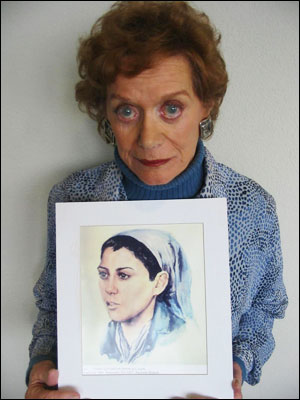 Legendary comic artists Neal Adams and Joe Kubert, and renowned wordsmith Stan Lee, himself are teaming on an important project that will involve Marvel, Dark Horse, and a movie? The three have joined to tell a story 65 years in the making about a Jewish woman forced to paint for the Nazis in order to save her and her mother from the gas chambers of Auschwitz during WWII.
Legendary comic artists Neal Adams and Joe Kubert, and renowned wordsmith Stan Lee, himself are teaming on an important project that will involve Marvel, Dark Horse, and a movie? The three have joined to tell a story 65 years in the making about a Jewish woman forced to paint for the Nazis in order to save her and her mother from the gas chambers of Auschwitz during WWII.
That woman, Dina Gottliebova Babbitt now 85, has tried for the last 35 years to secure the return of seven of those portraits to preserve her legacy and the memories of the subjects who were sent to death.
The Museum displaying the paintings has refused to return them to Dina, and tried to justify this with untenable position that they belong to the "Angel of Death", Dr. Josef Mengele, who forced Dina to paint them in 1944.
Sounds like a great plot for a graphic novel, doesn't it?
Well, it is but this story really happened. These three superstars of the comics universe have united with 450 other cartoonists, artists, writers, the U.S. Congress, and other media and activist organizations, to ensure that this tale with its horrific beginnings will finally have a happy ending.
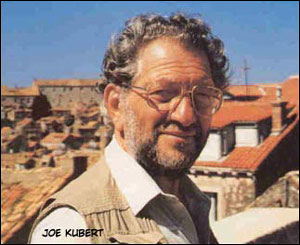 Followers of Joe Kubert may recognize the similarities between this story and Kubert's Yossel: April 19, 1943, published in 2003.
Followers of Joe Kubert may recognize the similarities between this story and Kubert's Yossel: April 19, 1943, published in 2003.
In that fictional graphic novel, Joe ("Yossel" in Yiddish) imagines his life had his family not emigrated from Poland prior to the Nazi pogroms of the 30s and 40s.
That, however, was where the fiction ended and the startling real-life story began for 19-year-old Dina Gottliebova, who like thousands of Jews was captured and awaited imminent death in the gas chambers of Auschwitz in 1944.
Dina Babbitt's Story
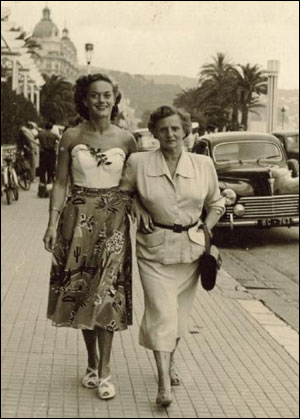 Like millions of Jews across Eastern Europe, Dina and her mother were collected and crowded into primitive barracks until their number came up to be herded into the gas chambers and eliminated. An artist before her capture, she used her cartooning talents to paint a mural on the wall of the children's barracks of Snow White and the Seven Dwarfs. The movie had been released in Europe several years earlier and was a familiar and calming influence the children in her camp.
Like millions of Jews across Eastern Europe, Dina and her mother were collected and crowded into primitive barracks until their number came up to be herded into the gas chambers and eliminated. An artist before her capture, she used her cartooning talents to paint a mural on the wall of the children's barracks of Snow White and the Seven Dwarfs. The movie had been released in Europe several years earlier and was a familiar and calming influence the children in her camp.
Because of the mural, Dina's talents came to the attention of the infamous Dr. Josef Mengele. The inaptly-named "Angel of Death" was the chilling personification of the nightmarish mad doctors who populate horror comics. However, this doctor's abominable experiments on human patients (Romany and Jew) would be too gruesome for even the most sinister comic criminal.
Among his other monstrous pursuits, Mengele tried to prove the genetic inferiority of Eastern European Gypsy (Roma) population thereby supposedly justifying their extirpation at the hands of the Nazis. Dissatisfied with the quality of photography at the time, the Mengele called on Dina to paint portraits of Roma prisoners, to accurately depict their darker skin colors. While Dina painted, Mengele spared her and her mother from execution. The subjects of her portraits were not spared, however, and after Dina had completed each painting, that gypsy inmate was sent on to their death.
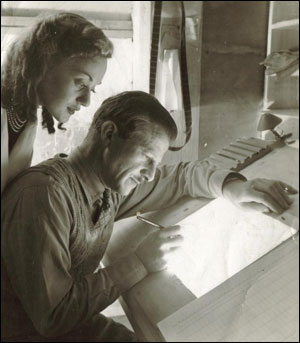 After the prison camp was liberated by the Allies in 1945, Dina met Art Babbitt - a former Disney artist, who coincidentally had been the lead designer for the character of Dopey in Snow White. Art was working at Warner Brothers in Paris, and hired Dina as his assistant. They married and soon moved to Hollywood, where she worked for many years at Warner Brothers, working on characters such as Wily E. Coyote and Tweety Bird.
After the prison camp was liberated by the Allies in 1945, Dina met Art Babbitt - a former Disney artist, who coincidentally had been the lead designer for the character of Dopey in Snow White. Art was working at Warner Brothers in Paris, and hired Dina as his assistant. They married and soon moved to Hollywood, where she worked for many years at Warner Brothers, working on characters such as Wily E. Coyote and Tweety Bird.
In 1973, six of the portraits were donated or sold to the Holocaust Museum in Auschwitz, Poland. (A seventh painting was later donated or sold by a similarly unidentified benefactor.) The Museum determined that Dina had been the creator of those paintings, and contacted her to fly at her own expense to verify this. Since she was their creator under the most extreme duress Dina naturally assumed that the Museum would be releasing the paintings and she would be returning with them to the United States. Although she fully intended to grant the Museum full rights to reproduce and display them, she was shocked and disappointed when the Museum refused to refused to release the portraits to her.
Imagine first, what it was to be Dina imprisoned in Auschwitz knowing that she had merely postponed the death of each of the subjects of her paintings. Then imagine Dina today, knowing that these portraits are all that remain of these people. Dina captured their essence their soul, as it were but can never hold the paintings again, give them to her children to honor the memories of these gypsy victims of the Holocaust.
Irresistible Force: Joe Kubert, Neal Adams, and the Comic Community
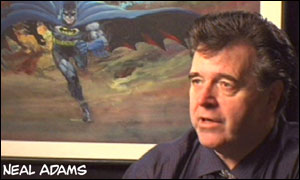 Mrs. Babbitt's first contact with the Auschwitz Museum was a 35 years ago, and despite her repeated requests the Museum is resolute in their position that she relinquished possession of the portraits during her captivity during World War II. This is where Dina Babbitt's came to the attention. Dina's plight came to the attention of comic artists, writers and cartoonists all over the world, through the David S. Wyman Institute for Holocaust Studies. The Institute's mission, according its Founding Director, Rafael Medoff, is to, "teach the lessons of America's response to Nazism and the Holocaust."
Mrs. Babbitt's first contact with the Auschwitz Museum was a 35 years ago, and despite her repeated requests the Museum is resolute in their position that she relinquished possession of the portraits during her captivity during World War II. This is where Dina Babbitt's came to the attention. Dina's plight came to the attention of comic artists, writers and cartoonists all over the world, through the David S. Wyman Institute for Holocaust Studies. The Institute's mission, according its Founding Director, Rafael Medoff, is to, "teach the lessons of America's response to Nazism and the Holocaust."
Artist Neal Adams picked up on the Institute's involvement, and how it led to the involvement of the comic community: "They were focused on Dina Babbitt," because her story related back to their area of concentration, Nazism and the Holocaust. "[T]hey were making an effort to get her paintings returned to her, so they called upon Rafael Medoff, who it turns out is a comic book fan!" Getting the cartooning community involved seem to be a natural step, given Medoff's affinity for comics and the fact that Dina had been a cartoonist for many years.
Medoff contacted Joe Kubert because of his intimate connection to the subject of the Holocaust: "The ironic part of this was one of the reasons Rafael had contacted me was that I had done [Yossel] After having visited the [U.S. Holocaust] Museum in Washington, I was so taken by the things I had seen and heard there, the thought struck me: What would have happened if my folks hadn't come out of Europe, didn't leave Poland at the time they did, back in 1926, which was prior to the Holocaust and all the things that occurred: I would still be a cartoonist, I would still love to do these kinds of drawings, but under vastly different circumstances."
Joe Kubert was an infant when his parents saw the writing on the wall and emigrated from Poland. However, most Eastern European Jews were not so prescient or lacked the resources to escape. He was a teen in New York as the Nazis cut a destructive path across Europe with one goal: The extermination of the Jews. "It was a horror. As a matter of fact, despite the fact that my parents took us out in 1926 myself and my older sister their family stayed. My father's family was completely wiped out: Cousins, father, mother, my grandfather, my grandmother, my uncle, everybody. Not only did they kill all the people in the town, but the town was wiped off the map."
As he was unaware of Dina Babbitt's story, Kubert relied only on his knowledge of the fate of his relatives when he concocted his own hypothetical tale of Yossel. Nevertheless, the parallels are uncanny between his imagined fate in that graphic novel, and the actual experiences of young Dina Gottliebova: "In Dina's story, the fact that she could draw saved her life and her mother's life, as well. That was the only thing that stood between her and going to the gas chamber. The fact that I could draw according to my 'What If?' story intrigued the Nazis within the town, within the area they were taking all the people and killing people. The only thing that had saved the kid, me Yossel, in the book was the fact that he could draw."
After reading Medoff's outline of Dina's story, Neal Adams realized it would be much more inspiring as a narrative story in the form of sequential art: A comic. "I read his outline, and I noted that the outline although it was just done in a series of paragraphs it was very efficiently written. There was no appeal to emotion; it was just facts. A listing of events: From this point when she was a little child to this point now, today. I read it, and I thought, 'You know what? That would make a good comic book story.' Just like that.
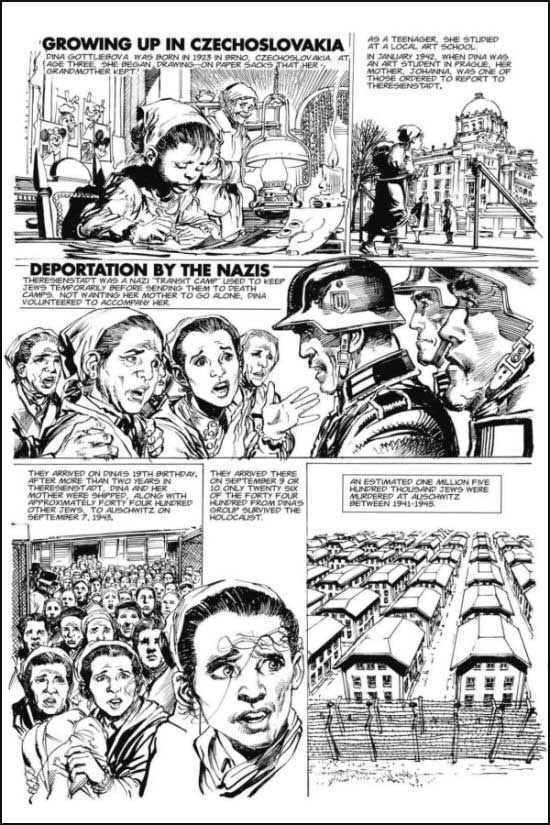
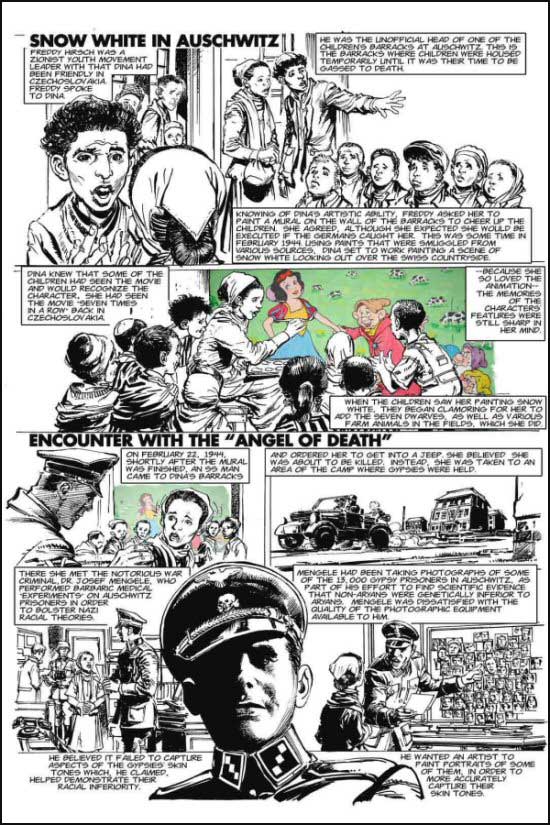
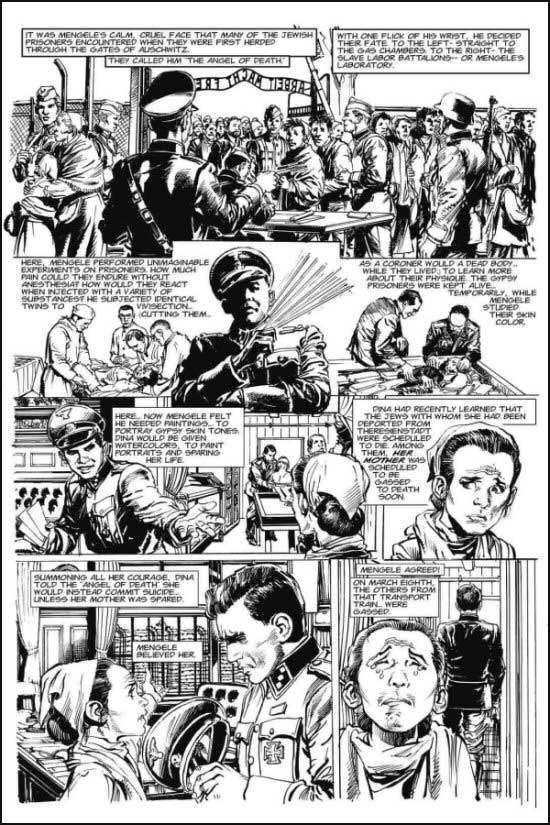
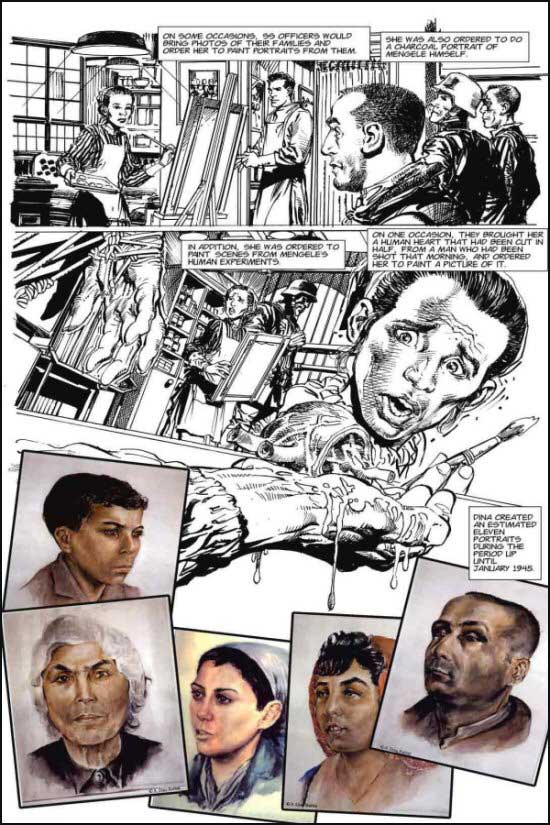
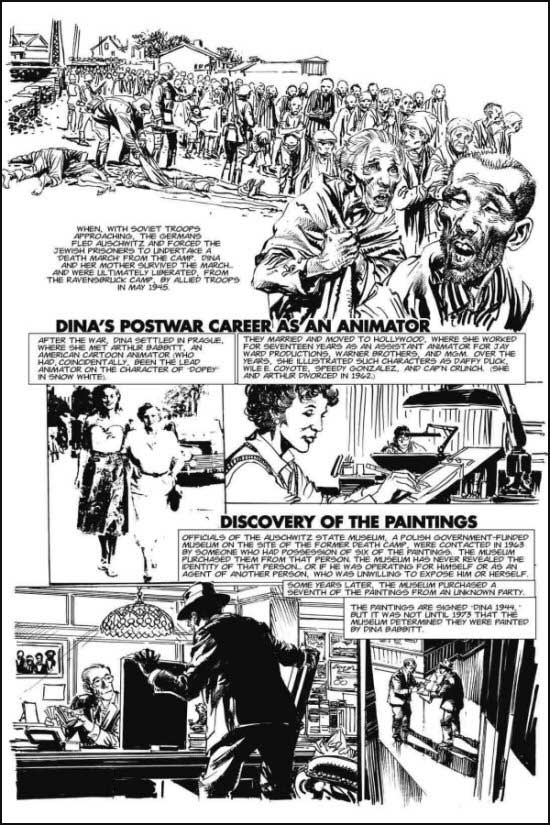
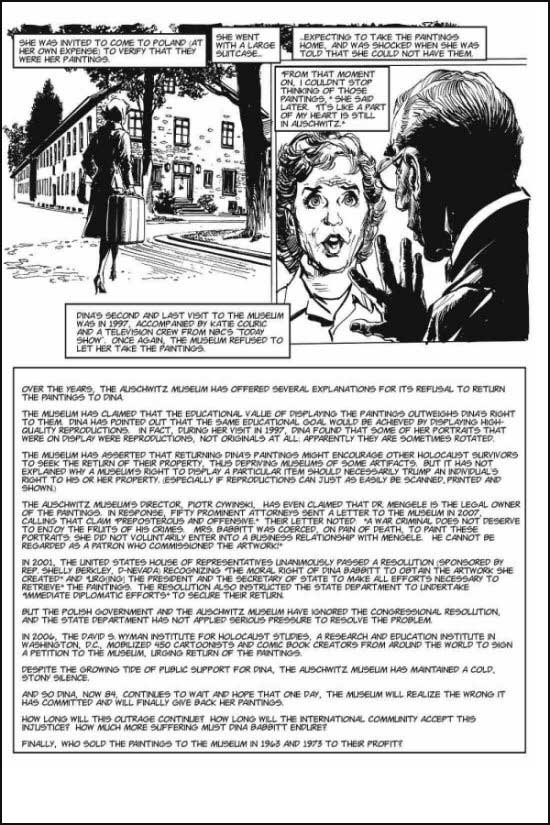
"[I]t only makes a six-page comic book story, but I didn't want him to do it any longer. I didn't want him to enter anything alien into it, or push it in a direction. I thought, if it just takes six pages, it just takes six pages. So I said to [Medoff], 'Look, I would like to draw this.'"
Once Adams had completed the six-page comic, it was Joe Kubert's turn to ink it. This was not the first time that Kubert had inked over Adams' pencils, but their previous collaborations took place in the early 1970s: Coincidentally, about the same time that Dina Babbitt first learned that her portraits had survived the liberation of Auschwitz at the end of World War II. Kubert recalled, "I've done work with Neal before. A good number of years ago, he had penciled an entire book for me when I was editing some stuff just because he wanted me to ink it. Which I did. So I've known his work for years and years" (For comic completists that book was Star Spangled War Stories (DC) #144 (May 1969) "Death Takes No Holiday" (23 pages) Written by Bob Kanigher, pencils by Adams, inks by Joe Kubert. This story can be found in the black-and-white reprint volume, Showcase Presents: Enemy Ace, Vol. 1.)
Kubert and Adams also worked together on Brave and the Bold #84 (June 1969), which told the story of another unusual "team up" between Batman of the 70s and Sgt. Rock in the middle of WWII. (Reprinted in, Showcase Presents: The Brave and the Bold Batman Team-Ups Vol. 2.) Oddly, Kubert only inked one page (19), perhaps as a tip of the hat from Adams for Kubert's signature character, Sgt. Rock. Well acquainted with Adams' work, therefore, Kubert was pleased with the modern collaboration: "When I saw the work he had done" on the Dina Babbitt story, Kubert commented, "I saw that it was up to if not beyond any work that he had done before."
 The core group was formed, but one member of comics' founding fathers was missing from the mix. Stan Lee, who has been called the father of modern superhero comics, was brought in to complete the triumvirate. The Wyman Institute contacted Lee, "asking if I'd be willing to be listed as a supporter of Mrs. Babbitt's cause. I replied that I would and so it began." He realized the historical and cultural importance of bringing her story to light and immediately jumped on. "When an interesting or worthwhile project or cause comes along, it's difficult not to want to become involved."
The core group was formed, but one member of comics' founding fathers was missing from the mix. Stan Lee, who has been called the father of modern superhero comics, was brought in to complete the triumvirate. The Wyman Institute contacted Lee, "asking if I'd be willing to be listed as a supporter of Mrs. Babbitt's cause. I replied that I would and so it began." He realized the historical and cultural importance of bringing her story to light and immediately jumped on. "When an interesting or worthwhile project or cause comes along, it's difficult not to want to become involved."
The man whom many call the father of modern comics, was delighted to pitch in: "I'm always interested in being involved in any worthwhile project," Lee stressed, and Dina Babbitt's cause was no exception. The creator of comics and pop culture icons such as the Fantastic Four and the Amazing Spider-Man, has written the introduction to Adams and Kubert's comic strip collaboration. Lee's intro will be included with the publication of the comic.
The response from the comics and cartooning community was incredible, as Adams commented that Medoff worked tirelessly to raise awareness
of Babbitt's problem and garner support: "[He] came to us, and he collected 450 signatures for this petition."
Immovable Object: The Auschwitz Museum
The Auschwitz Museum has refused to soften their stance, however, despite public pressure and three decades of pleas from Mrs. Babbitt. "To date, the Museum's Director has not responded to the petition by the 450 artists and comic book creators that we sent, more than two years ago," commented the frustrated Medoff.
In fact, only Neal Adams has received any written response from the Museum: "They've written me two letters, and apparently I'm the only person who they've written letters to They explain their position, and unfortunately for them, I have had some experience in this whole idea of returning artwork to people who created it, and under what conditions. I'm not the right person to write this stuff to! So, I write letters back, and try to explain it..."
The Museum's response is shocking, as their letters to Adams detail their justification for keeping the paintings. The Museum, he said, is "defending a position that is un-defendable: That perhaps the art belongs to Mengele." Medoff was equally incredulous: "Museum officials made matters even worse with their grotesque and insulting remarks about Dr. Mengele supposedly being the real, or only legal owner of the artwork."
Mrs. Babbitt has always offered to allow the display of Museum-quality reproductions, but the Auschwitz Museum has responded that this is insufficient. In its correspondence with Adams, it asserts that the interest of the public can only be served by displaying the original paintings. "So far, the Museum dug in its heels," lamented Medoff. "But they do not have a reasonable case. The fact that they already sometimes display reproductions of the paintings rather than the paintings themselves blows a gigantic hole in their position."
"Dina was not hired to do this," Adams stressed. "She did it under threat of death, and she managed to save her mother's life by doing it. That doesn't give anybody the right to own these, but her."
Medoff is hopeful, however, that increased public awareness will turn up the heat on the Auschwitz Museum: "[I]t's just a matter of whether the public will just forget about it and go away. My sense is that when Neal Adams' comic strip is published, there will be another significant wave of public interest and public attention that will hopefully force the Museum to sit up and take notice."
Although Dina Babbitt is one of the few living survivors of the global and historical tragedy known as the Holocaust, it is important first to recognize that Dina Babbitt is a human being. Although she serves as an historical legacy of a tragic period, her personal goal is simply to provide a personal legacy for her family a reminder of who she is and where she came from. Rafael Medoff stated it succinctly: "She does not want to be pitied. She does not see herself as a victim, she sees herself as someone who simply is trying to regain what she created with her own hands. She is deeply grateful to the community of comic book creators, artists, writers and cartoon animators who have rallied to her side. She herself was a cartoon animator for many years, and she told me again and again how appreciative she is that today these cartoonists and animators regard her as a kindred spirit, and have tried to help her."
Campaign through Comics
What is the future of six-page comic drawn by Adams and Inked by Kubert? "We're talking to Marvel Comics, who is going to print the story in one of their comic books. So, many, many people - hundreds of thousands of people - will be able to see it... and possibly send copies all over the world."
Adams added that the story will not stop at Marvel: "I am told that Dark Horse is interested in doing a similar thing. I am told that conversations are happening with an arm of Disney, who is considering doing it as a small book, and possibly as a documentary."
In addition, Medoff noted, "the Wyman Institute is organizing an auction of original artwork, original comic strip and comic book artwork, to raise money for the campaign to get her paintings back. We have received contributions from many prominent artists, but we're still in the process of soliciting contributions of artwork. Then probably it will be an online auction in the near future." He noted that J. David Spurlock of Vanguard Publications is helping to organize the auction.
Medoff stressed that only increased publicity and pressure will persuade the Museum to return to Dina her rightful possessions. It is "going to stand still until the point where the public pressure and the publicity is so embarrassing that they realize that it's not worth paying that price any more. So, to a certain extent, the outcome of this struggle is in the hands of the public and interested groups like the comic book community. Like any museum, like any government institution, they will respond if there is sufficient pressure, if there is sufficient mail, phone calls, email, Congressional interest, and the like."
"[T]here is a great deal that can be done by the comic art community and the public in general," stressed Medoff. "The Museum is beginning to feel the pressure, but they have not felt enough pressure yet. The Neal Adams comic strip, which I had the honor to help create, has generated a new wave of public interest in this issue, and we hope that as the strip gains further attention when it is published, that the Museum will finally reconsider and undo the injustice that they have committed."
Activist Neal Adams was more effusive: "We will be doing anything and everything to cause this thing to end! So, anybody who wants to help, we will be glad to beg... and allow you to print my work for free, and show it, and tell the story. We're also asking people on a regular basis, with any of these things we do: Please send letters. We're not giving you a form letter to send. What we're doing is we're telling you the story, so that you 100% know the story from this little comic book, and now you can send your own letter."
Conclusion...?
In the end the natural question to ask might be why we should be so concerned whether Dina Babbitt should get her paintings back from the Auschwitz Museum. Or, to put it another way, why do the rights or desires of this one artist outweigh the rights or mission of the Museum itself? On the most basic level, the question boils down to this: From a legal or purely practical standpoint, who owns any piece of art? If an artist creates a piece of art for hire - under a contract - then the person who contracted for that art owns the work, and may later sell or gift those pieces of art at will.
Neal Adams himself fought for the rights of comic book artists for years to secure the return of their original art pages from the comics companies (DC and Marvel). On one level, the publishers took the position that the pages were "works for hire" and they could continue to destroy the pages (to prevent their re-publication overseas, where American copyright law was ineffective.) Adams and the artists essentially claimed the companies merely had publication rights, and the originals themselves belonged to the artist. (The artist couldn't republish the pages, but they could keep or sell the originals to collectors.)
In the end, the issue was not so much legally settled, as it was morally. The companies had originally paid a small amount for these pages, published them, and made their profit. They retained publishing rights (for reprints - for which the artists never saw payment or royalties) and to return the originals to the artists did nothing to dilute those publishing rights. In other words, there was no legal or practical reason for the publishers not to return the originals to the artists. More importantly, the amount of bad will the publishers accumulated in the court of public opinion forced their hands - they simply looked greedy and uncaring by refusing to return the original pages. Later, they garnered favorable public perception by simply returning the art pages and allowing the artists do with them what they wanted.
As for the moral angle - and public perception the Dina Babbitt's issue is similar. The Auschwitz Museum - despite its laudable stated goal to memorialize the tragedy of the concentration camp - does not own these works of art, because they did not buy or commission them from the artist. To circumvent that detail, they have used the deplorable excuse that somehow they came into possession of the paintings indirectly through Mengele himself. (It may also be significant that the Museum has never disclosed the paintings' benefactor, a fact that could further cloud their claim to title.) They dance around the language, but Mr. Adams' contacts have essentially indicated to him that Mengele "commissioned" the pieces, and therefore by extension the Museum has ownership rights.
Even were this ludicrous position correct, then they should return the originals to Mrs. Babbitt because the Museum still retains the rights to display high-quality reproductions. Just as Marvel or DC retain the rights to publish when they return the original art pages to their artists, the Museum could easily return the originals to Mrs. Babbitt, while retaining the rights to "publish" copies.
More importantly, the Museum's claim falls flat because these paintings were not works for hire. She was not paid nor did she create them under any employment agreement or contract. She was forced to create them under extreme duress : the threat of death to her and her mother.
So, the Museum's claim of ownership to these paintings are legally - and morally - groundless. They don't "own" them - even if they did buy them from someone 35 years ago - any more than you would "own" original comic art pages that someone stole from the artist and sold to you. The paintings legally - and morally - belong to Mrs. Babbitt, because she was forced to paint them under threat of death.
The Museum's final argument is that its mission to memorialize the atrocities of the Holocaust morally outweighs the Mrs. Babbitt's individual rights. This is a simplistic and specious argument, and simply does not apply: The Museum can fulfill its mission, without wrongfully withholding the rightful property of one of the few surviving victims of that horrendous period in modern history.
So how do Mrs. Babbitt's "needs" - the desire for the return of her art - outweigh that of the Museum's? This is her legacy - the creation from her own mind and hands - literally her own blood, sweat and tears - that she can show her own children and grandchildren. This is important to her and them to preserve her memory and her contribution to the world. That's what these paintings mean to her, and that alone is reason enough that they should be returned to her.
These paintings, however, represent much more than just a statement of the needs and desires of one victim. They are, rather, representative of a symbol of one of the most horrific examples of inhumanity and injustice in history. If we continue to look the other way and say "no big deal" to vivid examples of this period in history, then we run the risk of falling prey to it again. When we become numb to the "minor" injustice of a Museum against an old woman, then we start to think it is acceptable when a government tells their citizens when they can go out at night or what they can and cannot say. When we turn away from the fact that a Museum withholds art that 65 years ago a girl was forced under threat of death to paint, then we start to turn a blind eye to torturing of prisoners or gradually depriving citizens of their civil rights. What starts out as a "minor" deprivation of one person quickly leads to the much larger unraveling of society.
Lest we think that is overstating the case, history shows that was the start of the Holocaust itself generations ago, and Dina Gottliebova was there at the beginning. It is a wound that has yet to heal, which the Auschwitz Museum can either continue to inflict against one family and their supporters, and by extension the families of the victims and survivors of an ethnic cleansing several generations past. Or the Museum itself can help the healing process by one simple act of kindness and cooperation.
Time is of the essence, as Dina's children and grandchildren stress in her website (www.dinababbitt.com) the status of her health is tenuous aggravated by her advanced age: "Dina, who is now 85, has just been diagnosed with an aggressive form of abdominal cancer." Dina's Daughter, Michele sent an update in January, 2009: "Dina survived major cancer surgery in 2008 and then, a few weeks ago, almost died again by somehow contracting E. Coli. However, she's with us, out and about, and getting her strength back. She is truly a survivor's survivor."
Michele noted, however, that the Auschwitz Museum remains uncooperative: In December, "the Museum Committee held its annual meeting and, once again, turned down her request. It's their special brand of sensitivity that they dump on us every year. But it's a new year and, as the saying goes, hope springs eternal."
As this article and all those interviewed stated, there is something that you, the reader, can do: Write a short email to the Director of the Museum, demanding that it return Dina's original paintings. Please send a brief email to the Director of the Auschwitz Museum. It need not be lengthy: Two or three sentences will be sufficient to get the point across. Your help is greatly appreciated.
Please direct your emails to the Director of the Auschwitz Museum:
Mr. Piotr Cywinski, Director
Auschwitz-Birkenau State Museum
Oswiecim, Poland
mailto:muzeum@auschwitz.org.pl
Please send a brief appeal to the Director. It need not be extensive: A couple of sentences would be sufficient to get the point across! Your help is greatly appreciated.

|
| This article originally appeared in modified format on The Pulse |

|
|
Writer Bruce MacIntosh is the self-styled Comic Czar at www.comiczar.com |




